
Sorghum is a genus of about 25 species of flowering plants in the grass family (Poaceae). Some of these species are grown as cereals for human consumption and some in pastures for animals. One species is grown for grain, while many others are used as fodder plants, either cultivated in warm climates worldwide or naturalized in pasture lands.

Saccharum is a genus of tall perennial plants of the broomsedge tribe within the grass family.
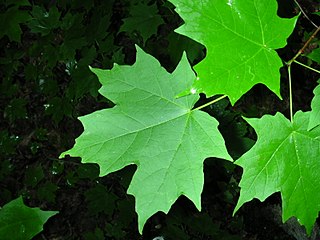
Acer saccharum, the sugar maple, is a species of flowering plant in the soapberry and lychee family Sapindaceae. It is native to the hardwood forests of eastern Canada and eastern United States. Sugar maple is best known for being the primary source of maple syrup and for its brightly colored fall foliage. It may also be known as "rock maple", "sugar tree", "birds-eye maple", "sweet maple", "curly maple", or "hard maple", particularly when referring to the wood.
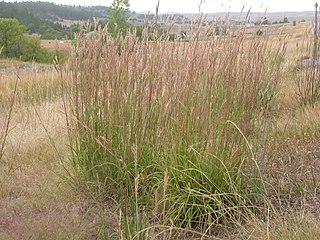
Andropogon gerardi, commonly known as big bluestem, is a species of tall grass native to much of the Great Plains and grassland regions of central and eastern North America. It is also known as tall bluestem, bluejoint, and turkeyfoot.
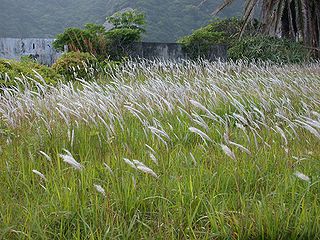
Imperata cylindrica is a species of perennial rhizomatous grass native to tropical and subtropical Asia, Micronesia, Melanesia, Australia, Africa, and Southern Europe. It has also been introduced to Latin America, the Caribbean, and the Southeastern United States. It is a highly flammable pyrophyte, and can spread rapidly by colonizing disturbed areas and encouraging more frequent wildfires.
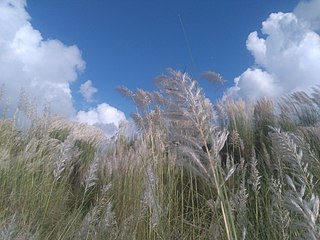
Saccharum spontaneum is a grass native to the Indian Subcontinent. It is a perennial grass, growing up to three meters in height, with spreading rhizomatous roots.

The Terai–Duar savanna and grasslands is a narrow lowland ecoregion at the base of the Himalayas, about 25 km (16 mi) wide, and a continuation of the Indo-Gangetic Plain in India, Nepal and Bhutan. It is colloquially called Terai in the Ganges Basin east to Nepal, then Dooars in West Bengal, Bhutan and Assam east to the Brahmaputra River. It harbours the world's tallest grasslands, which are the most threatened and rare worldwide.

Jerdon's babbler is a passerine bird native to wetlands and grasslands of the Indian sub-continent. It is listed as Vulnerable on the IUCN Red List since 1994. It is a member of the genus Chrysomma of the family Paradoxornithidae.

Puccinia melanocephala is a plant pathogen, it is the causal agent of sugarcane rust. This pathogen affects multiple species of sugarcane, including Saccharum spontaneum or wild sugarcane, Saccharum robustum, and the most commonly cultivated species Saccharum officinarum. Puccinia melanocephala can also infect other member of the family Poaceae, including some species of bamboo such as Bambusa vulgaris. The first symptoms of sugarcane rust are elongate, yellow-colored leaf spots, roughly 1mm to 4mm in length. The leaf spots gradually become bigger and turn a reddish-brown color. The uredia develop underneath the epidermis where the leaf spots are present. When the uredia become big enough, they break through the epidermis to form the characteristic rust pustules from which uredospores are borne. These pustules can coalesce, resulting in large areas of dead tissue.

Sugarcane or sugar cane is a species of tall, perennial grass that is used for sugar production. The plants are 2–6 m (6–20 ft) tall with stout, jointed, fibrous stalks that are rich in sucrose, which accumulates in the stalk internodes. Sugarcanes belong to the grass family, Poaceae, an economically important flowering plant family that includes maize, wheat, rice, and sorghum, and many forage crops. It is native to the warm temperate and tropical regions of India, Southeast Asia, and New Guinea. The plant is also grown for biofuel production, especially in Brazil, as the canes can be used directly to produce ethyl alcohol (ethanol).

Imperata is a small but widespread genus of tropical and subtropical grasses, commonly known as satintails.
Tripidium arundinaceum, synonym Saccharum arundinaceum, commonly known as hardy sugar cane, is a grass native to tropical and subtropical Asia from India to Korea and New Guinea.

Phalaris minor is a species of grass native to North Africa, Europe, and South Asia. The bunchgrass is widely naturalised elsewhere.

Lygeum is a genus of Mediterranean plants in the grass family. It is placed in its own tribe Lygeeae, which is sister to Nardeae.

Hyparrhenia hirta is a species of grass known by the common names common thatching grass and Coolatai grass. It is native to much of Africa and Eurasia, and it is known on other continents as an introduced species. In eastern Australia it is a tenacious noxious weed. In South Africa, where it is native, it is very common and one of the most widely used thatching grasses. It is also used for grazing livestock and weaving mats and baskets.

Tripidium ravennae, synonym Saccharum ravennae, with the common names ravennagrass and elephant grass, is a species of grass in the genus Tripidium. It is native to Southern Europe, Western Asia and South Asia. It is known in North America as an introduced species, where it is sometimes an invasive and troublesome noxious weed.

Panicum repens is a species of grass known by many common names, including torpedograss, creeping panic, panic rampant, couch panicum, wainaku grass, quack grass, dog-tooth grass, and bullet grass. Its exact native range is obscure. Sources suggest that the grass is native to "Africa and/or Asia", "Europe or Australia", "Eurasia", "Australia", "Europe, Asia, and Africa", or other specific regions, including the Mediterranean, Israel, and Argentina. It is present in many places as an introduced species and often a noxious weed. It has been called "one of the world's worst weeds."
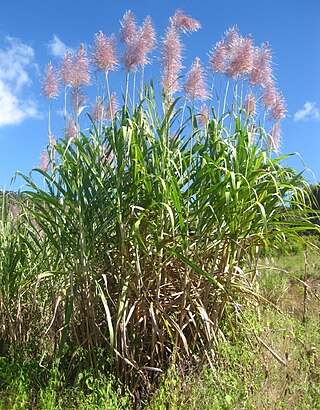
Saccharum officinarum is a large, strong-growing species of grass in the genus Saccharum. Its stout stalks are rich in sucrose, a simple sugar which accumulates in the stalk internodes. It originated in New Guinea, and is now cultivated in tropical and subtropical countries worldwide for the production of sugar, ethanol and other products.
Commonly known as Philippine downy mildew, this disease is caused by the species Peronosclerospora philippinensis of the fungal-like protist class Oomycetes, which also has members such as water molds and Phytophthora infestans, which caused the potato blight that led to the Great Irish famine.

Saccharum sinense or Saccharum × sinense, synonym Saccharum × barberi, sugarcane, is strong-growing species of grass (Poaceae) in the genus Saccharum. It is originally cultivated in Guangzhou, China where it is still commonly grown. It is a more primitive form of sugarcane with a hybrid origin from wild species of cane. A number of clones exists that are often included in the S. officinarum species as the Pansahi group. The most notable member of which is the Uba variety of cane. They are a perennial plant that grows in erect clumps that can reach up to 5 meters in height and have a red cane with a diameter of 15 mm to 30 mm.


















